Désolé, cette page est uniquement disponible en Anglais.
1. August 2025
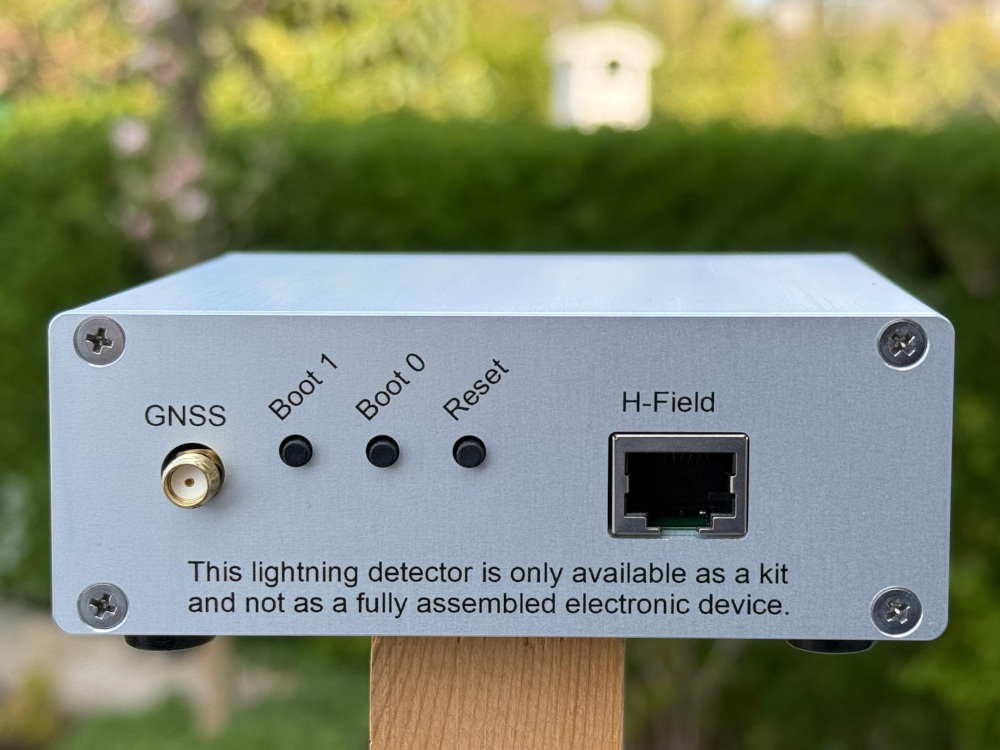
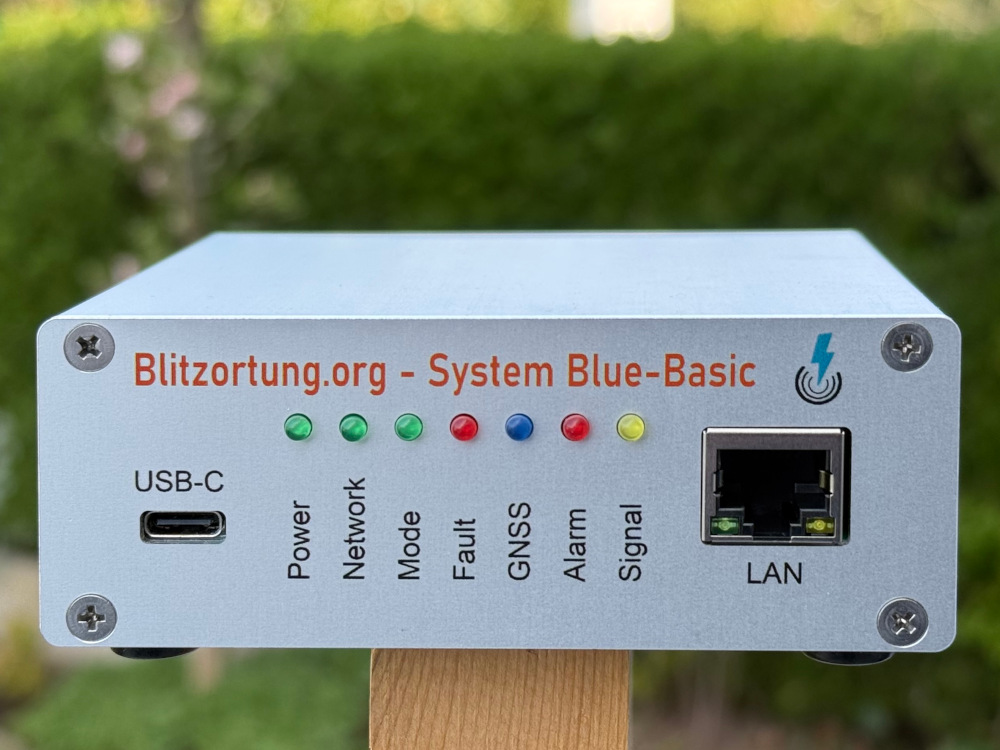
Board 22.2 has been slightly improved and is now available in version 22.2c. The changes concern the wiring of the external connections for the LEDs and the three buttons. These signals have been routed to a pin header. With an additional breadboard, seven LEDs and three buttons can be easily routed to the front and rear of the housing. The breadboard contains no SMD components. Only the LEDs, buttons, and a female header must be manually soldered onto the board. The front and rear panels have been slightly modified to accommodate the new components. In addition, the 4.5-volt voltage converter LP5907MFX-4.5NPB for the preamplifier power supply has been replaced with the current limiter MIC2009A-2YM6-TR. This limits the preamplifier current to a maximum of 200 mA and protects against damage if the H-field preamplifier connection cable is swapped with the LAN cable on the detector.
6. Juli 2024
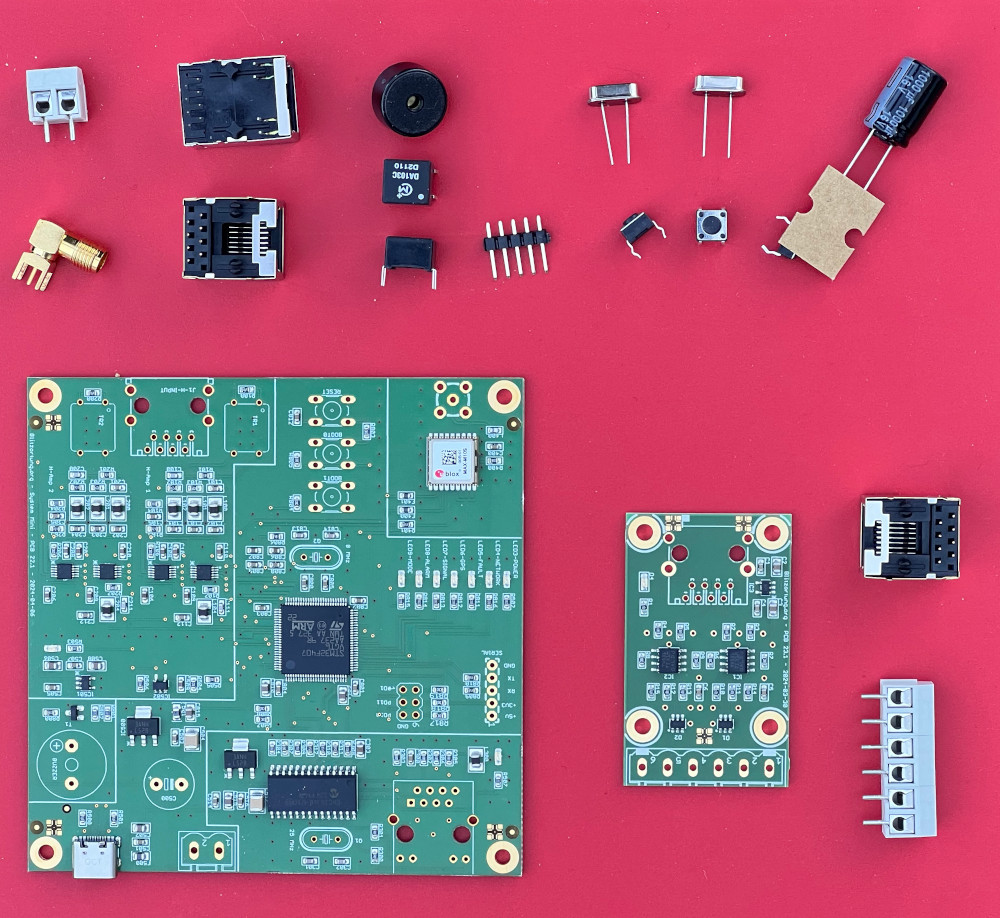
The System Blue Basic, or Blue Basic for short, is a System Blue in which some unimportant components have been omitted for cost reasons. It still supports two H-field channels, the primary application of the detectors. The third H-field channel and the E-field channel have been omitted. Furthermore, certain filter options that should only be used in noisy environments have been omitted. The detector works optimally with the 23.1 preamplifier board. The new GNSS module is the u-blox MAX-M10S. It supports the simultaneous reception of various GNSS signals (GPS, GLONASS, Galileo, and BeiDou). Blue Basic is now powered via a USB-C port. Possible front panels for installation in a 100 x 100 mm metal housing are in preparation.
15. January 2024
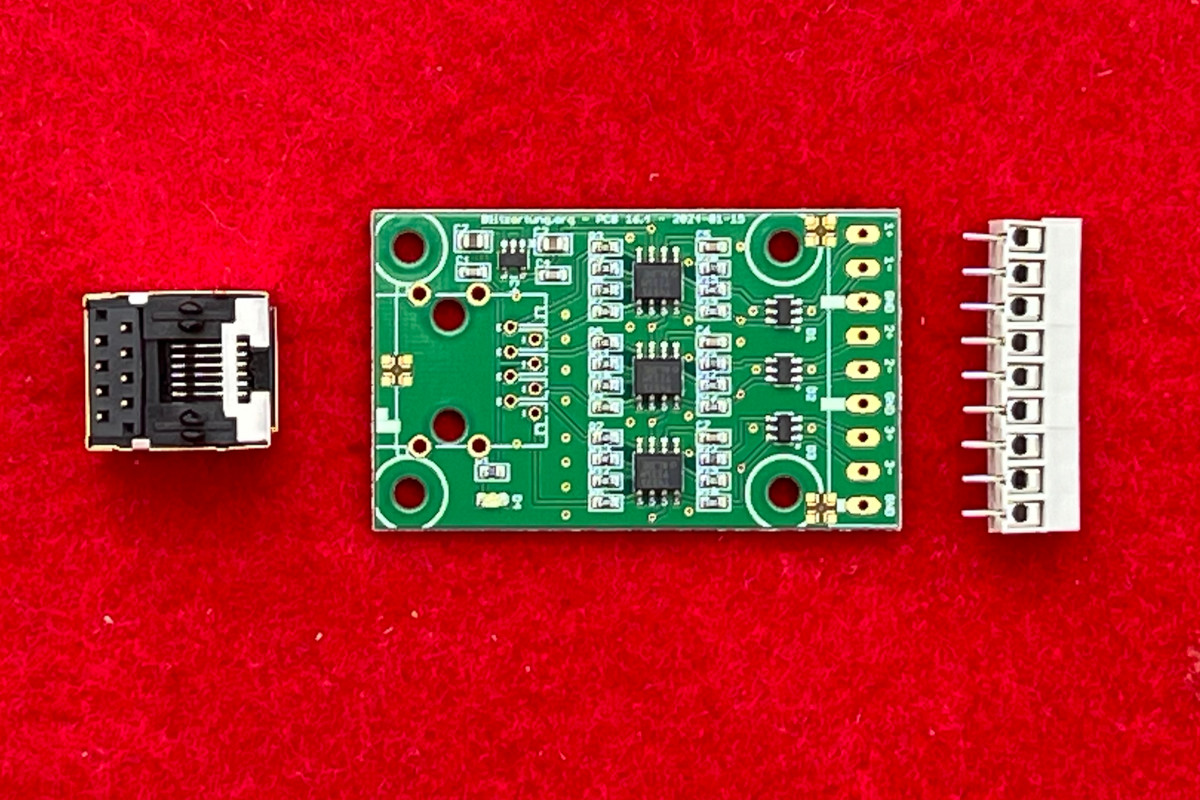
The H-field preamplifiers for the System Blue detector are now also available as individual boards. Originally, the H-field preamplifiers were only delivered together with the detector on one panel. With several preamplifiers, several different antenna systems, such as ferrite antennas and loop antennas, can now easily be exchanged. This makes it easier to test different antennas. In addition, individual preamplifiers often fail due to weather conditions. The boards can up to now be delivered in any quantity. Simply contact us by email.
1. January 2024
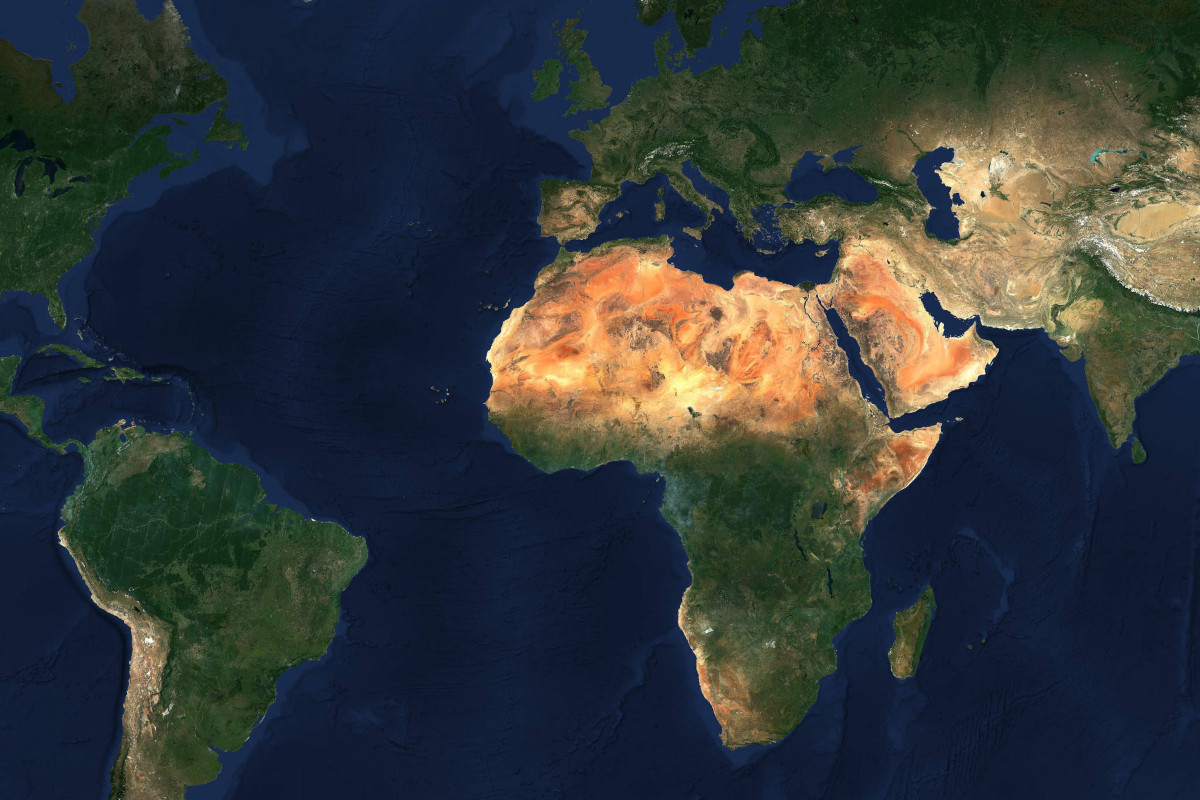
Since the end of 2023, we have been using the Sentinel-2 cloudless Copernicus satellite images from 2022 in the vector map. These were provided to us by EOX IT Services GmbH with a resolution of up to 10m per pixel. Sentinel-2 cloudless is part of the EOxCloudless Product Family, which offers source data for viewing and analysis. Copernicus is the Earth observation component of the European Union Space Program, managed by the European Commission and implemented in partnership with the EU Member States, the European Space Agency (ESA), the European Organization for the Exploitation of Meteorological Satellites (EUMETSAT), the European Center for Medium-Range Weather Forecasts (ECMWF), the Joint Research Center (JRC), the European Environment Agency (EEA), the European Maritime Safety Agency (EMSA), Frontex, SatCen and Mercator Océan.
21. January 2022
We are very pleased that the production of the ferrite rod antenna could be continued by someone else. The new supplier manufactures the ferrite rod antennas according to the same specifications as before. All antennas are technically checked before sale. Antennas of different lengths and different diameters are available. They can be ordered via the following website.



27. November 2019
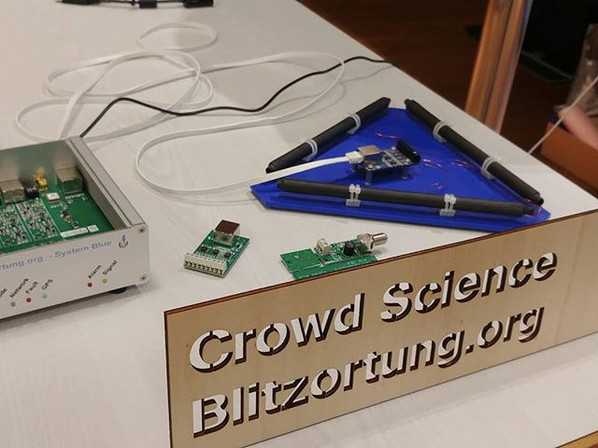
The Swiss Federal Office for Environment (BAFU Bundesamt für Umwelt) has set up the task of providing data and information that can serve as a basis for environmental discussions and decisions. For this purpose, the BAFU operates observation programs and measuring networks. Today a meeting of the BAFU took place at Lake Thun, where various digital projects were presented. One of these projects for environmental observations was the lightning location network Blitzortung.org. More Images can be found at Instagram.
9. August 2019
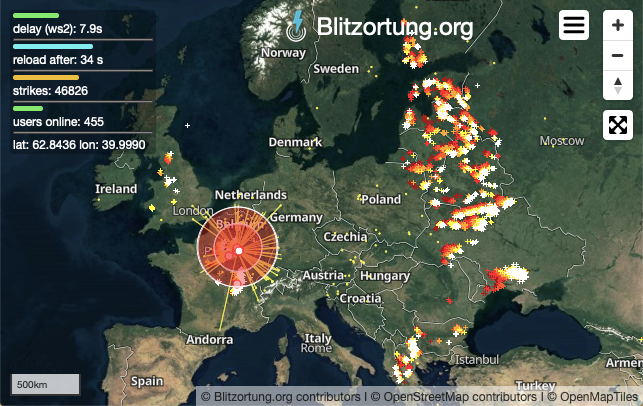
After the discontinuation of the Google Maps for cost reasons, the main focus in the last 6 months has been on the development of a new dynamic map. The use of vector tiles unfortunately requires a bit more resources on the browser side, but in contrast to the old maps one has more possibilities to realize things very easily. Vector graphics make the system highly flexible. The new maps are now based on data from OpenStreetMap and are therefore probably permanently available free of charge. Thanks to all contributors of OpenStreetMap.
23. April 2019
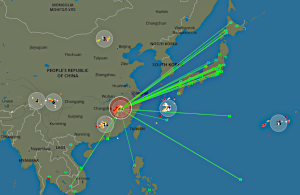
The number of stations in Japan and the surrounding area has increased considerably. This has made the East Asian area around Japan its own region within the lightning detection network. This spring, more stations will be put into operation. Together with the stations in Vietnam, Cambodia, Thailand and Malaisia, it is possible for the first time to detect lightning over East Asia.
17. June 2018


Detector number 2204 was built on the Mountain Hochfelln in Bavaria/Germany at an altitude of 1700 meters. The station already set a reception record of over 11700km after one day. Here are some pictures of the construction.
13. June 2018
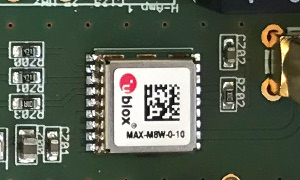
The old GNSS module was unfortunately no longer available. Therefore, a new GNSS module was integrated on the new Board 19.5, the UBLOX MAX M8W. The MAX-M8 modules utilize concurrent reception of up to three GNSS systems (GPS/Galileo together with either Bei-Dou or GLONASS) for more reliable positioning.
27. March 2018
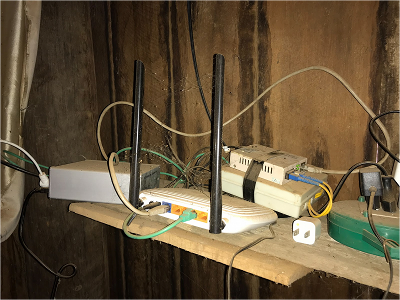
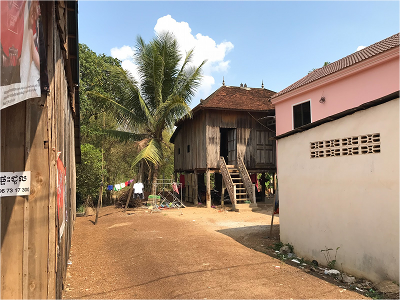
The repair or maintenance of a detectors can be very cumbersome in remote areas. The GPS had failed for some unknown reason at detector number 2010 in Krong Suong, Cambodia. To reach this detector, a distance of over 100km had to be covered. Such a journey through Cambodia usually takes 6 hours. Dust is a particular problem in this region. A Detector only works for a few months. After a few months, a detector looks like the one at the picture below.
20. November 2017
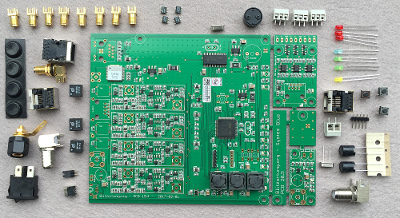

The new detectors with the mainboard 19.4 are finally available after a long waiting period. The improvements included among other things the noise immunity of channel A and the zero lines of four channels. An additional grounding socket was attached to the backpanel of the housing. This now well-working version of the detector will be offered in 2018 in larger quantities.
29. April 2017
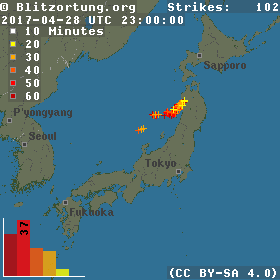
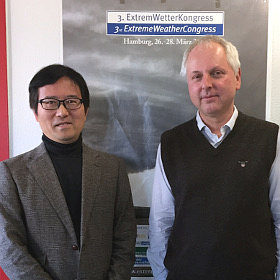
Meanwhile, there is a considerable number of stations in Japan such that our lightning location already works quite well there. More stations in Japan are being built. A large number of these stations are operated by Professor Tomomi Narita who visited us in Düsseldorf in April 2017. So another country has joined our projekt. Have fun with Blitzortung.org in Japan.
19. September 2016
More and more stations in Asia. The number of stations in Asia is steadily increasing. Meanwhile, there are stations in Singapore (1), Qatar (1), Thailand (1), Cambodia (1), Hong Kong (1), Macao (1), Kazakhstan (7), and Japan (13). Not all stations are online. Many of them are in test mode. Since a dedicated computing servers for Asia is still missing, the stations from Asia are additionally assigned either to the European region or to the Oceania region.
28. May 2016
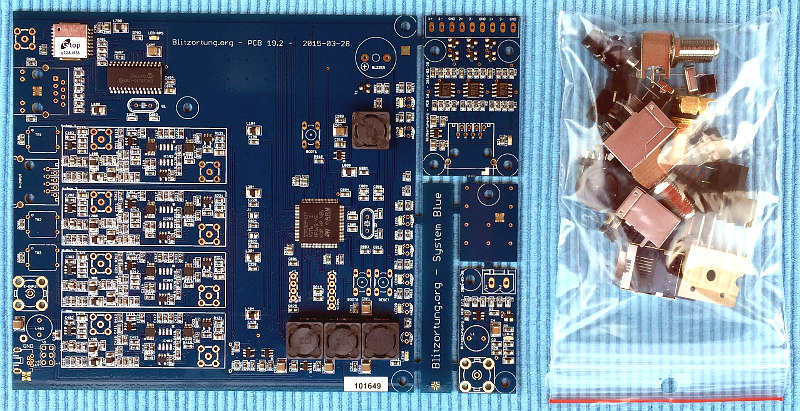
We have started with the delivery of the new System Blue kits. The first 50 stations were ordered within the first 24 hours. Since the demand is currently very high, additional detectors are already reordered. Unfortunately it always takes some weeks until the boards are manufactured and soldered.
9. March 2016
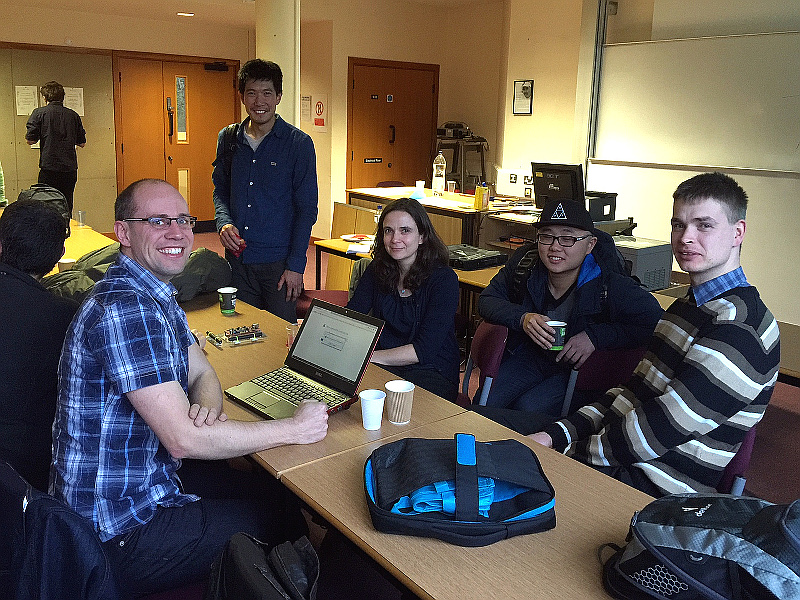
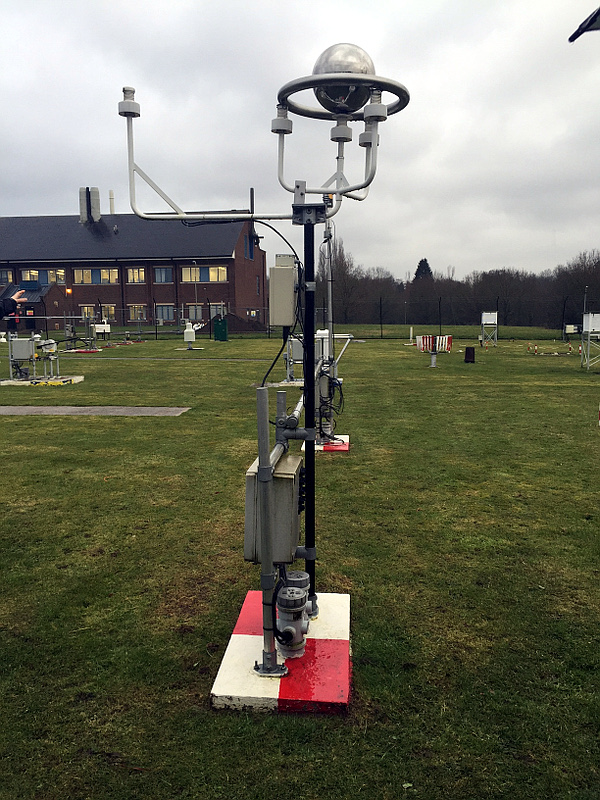
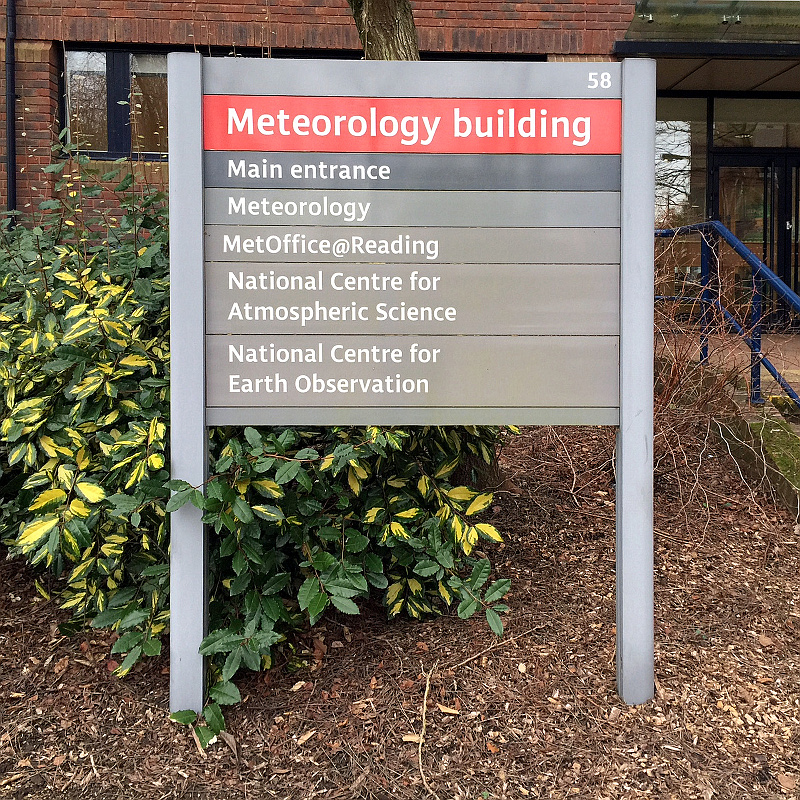
Blitzortung.org was presented at the meeting "Advances in Lightning Detection Methods" at University of Reading in the UK. This meeting seeks to review the current technology available for lightning detection, including ground based radio detection and electrostatic methods, as well as satellite detection methods. Current limitations of the technology as well as future developments will be discussed by experts from both the lighting detection industry as well as academia.
29. February 2016

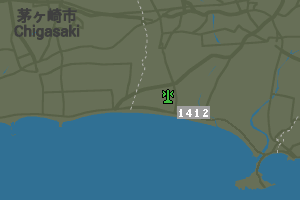
Blitzortung.org has its first participant from Japan.
10. Januar 2016
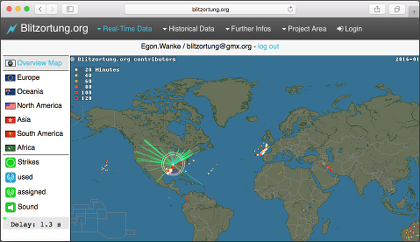
The web pages of Blitzortung.org have been adapted to improve the readability of most of our pages on mobile devices. This modification also affects the language dependent menus. If your native language is not supported then please contact us at info ☺ blitzortung.org. We send you further information how to install a missing language.
12. April 2015
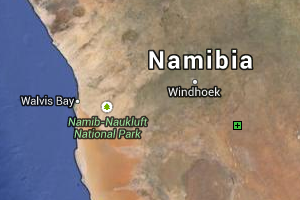
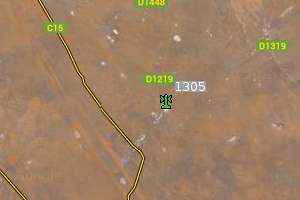
Blitzortung.org has its first participant from South Africa.
27. March 2015
Blitzortung.org was presented in the German television broadcast "alle Wetter" (all about weather) of Hessischer Rundfunk, Germany. The host of the show Thomas Ranft talked with Egon Wanke about how lightning detection works in our network. "alle Wetter" is a 15 minute live show broadcasted daily from Monday to Friday from the "Main Tower" in Frankfurt am Main. It starts with wind and weather on the observation deck at about 200 meters above sea level. Then it continous at Europe's highest television studio on the 53rd floor.
Tobias Volgnandt was also present and took a few photos for us.
21. Januar 2015
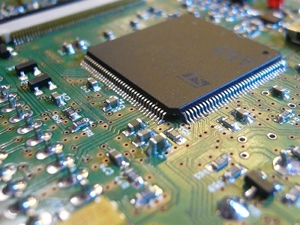
Announcement of System BLUE
In recent weeks, we get more and more requests for our forthcoming lightning detection hardware, called System BLUE. We are working very intensive on the development of this system, but can still not say any fixed date when it will be available. Maybe we can offer these systems in spring or summer 2015.
The main differences between System BLUE and System RED are the following: The System BLUE main board will be offered already assembled, gets some additional digital components, and some changes in the analog part. Due to the automatic assembling process we mainly use SMD parts. The main board is designed such that it fits into a housing that we also want to offer. In best case, you will get a completely assembled main device.
Note that we do not further offer controller or amplifier boards of System RED. We only still have a few kits as reserve for the case that some well-functioning stations fail or for strategically very important locations (North Pole, South Pole, Mount Everest, ...  ). Please do not request these kits but leave your e-mail address with your location on the Cover your Area page.
All participants that currently are running a system RED do not need to update their system. The signal quality of System RED is excellent and currently the best we have. Up to now, we have no experiences with System BLUE, but hope that the signal quality will be at least as good as for System RED.
21. November 2014

Blitzortung was presented at the 2014 New Zealand Meteorological Conference, to which we had an excellent outcome for the Blitzortung Community. The Conference ran for 3 days from the 19th to 21st of November and explored various parts of the Worlds Atmosphere, Climate and specific Meteorological Events that New Zealand and the World has had. Lightning Research and characteristics in New Zealand where also discussed. A big thank you goes towards the organisers of the conference.
Program of the 2014 New Zealand Meteorological Conference, Wellington, New Zealand
12. August 2014
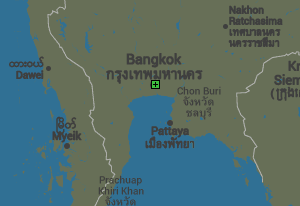
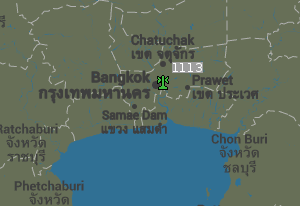
Blitzortung.org has its first participant from Bangkok.
25. June 2014
To see lightning in almost real-time, we have added a new animation. Each lightning strike is marked with a white expanding circle. The locations of the stations involved with the computation are visualized by green and blue lines. The blue lines are pointing to the stations whose information is definitely used. These are at most 12 of the nearest stations. The green lines are pointing to the stations that also have received the strike. The delay is usually between 3 and 6 seconds. If the storm is more than 2 km away, it can be seen earlier on the map as the thunder is heard. 
10. June 2014
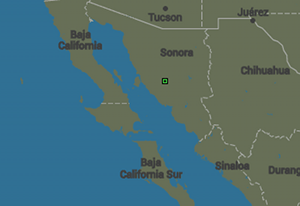

Blitzortung.org has its first participant from Mexico.
15. May 2014
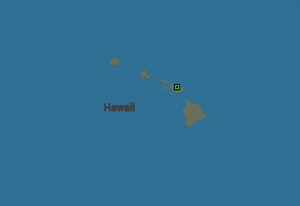
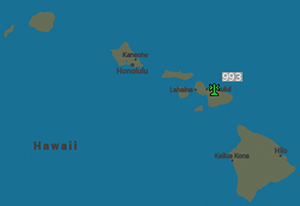
Blitzortung.org has found its first participant amid of the Pacific Ocean. The new station in Hawaii has been in operation since a few days. Due to the specific position, the station sends its data to our server for North America and our server for Oceania.
9. May 2014
Blitzortung.org was present at the Big Techday 7 in Munich, Germany, on May 23nd, 2014.
The Big Techday 7 is a one-day conference on science and technology, particularly IT. It is organized by TNG Technology Consulting GmbH Munich, because it is fun. The program is similar to the agendas of its predecessors. The general lecture program starts out with up to six parallel tracks and up to 35 talks. About 500 guests are expected.
Program of the 7th Big Techday 2014, Munich, Germany
3. May 2014
The amplifier/pre-amplifier set PCB 13 and PCB 14 for e-field antennas is now available. A vertical arranged e-field antenna receives lightning signals from all directions around. The e-field antenne can also be used to determine the polarity of the signals. A wire between 20cm and 2m is sufficient for good results. However, the e-field antenna is very sensitive with respect to disturbances. It has to be placed outside of buildings and far away from electric devices.
26. March 2014
Announcement of new additional amplifier boards:
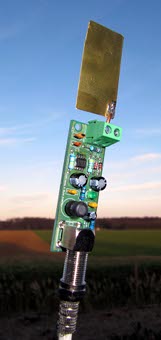
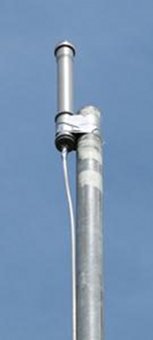
In a few weeks, we introduce a solution for the use of an electric antenna. Any wire or copper surface can be used as electric antenna. The antenna is connected to the small preamplifier PCB 14. The signal from the preamplifier can be passed through coaxial cable up to 100 meter to the amplifier PCB 13. Amplifier PCB 13 uses an adapted high-pass filter and in contrast to amplifier PCB 12 three different low-pass filters routed to the three input channels of the controller. The electric antenna should be at least 5 meters outside of living areas or houses, otherwise the interference of electrical household appliances can be too large. We will inform you here when the boards PCB 13 and PCB 14 are available.
24. September 2013
Blitzortung.org was present at the 8th SevereWeatherCongress 2013 in Hamburg, Germany.
A lot of renowned experts and well-known speakers have participated this year to the SevereWeatherCongress. They presented the current state of science, regarding extreme weather, in a clear and exciting way, answering to questions of the media as well as the public. With well over 1.500 participants the SevereWeatherCongress has become one of the most significant conferences regarding this subject, developing into an important interface between science and the public. It is one of the largest reunions of weather and climate related personalities, such as climate research scientists, well-known TV and radio meteorologists, science editors, the related service industry and the general public, who are all interested in questions related to weather events and climate change. A continuously growing exhibition complements the conference. This is where companies and scientific institutions present their innovations, products and services.
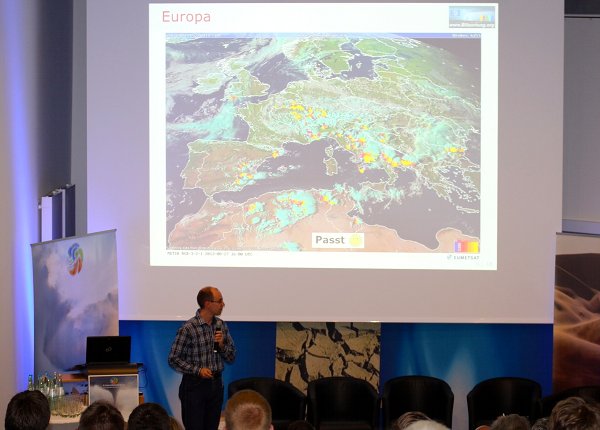 Tobias Volgnandt explained how lightning detection works. Picture: Hans-Martin Goede
8. July 2013
System RED is now available. Here are some of the advantages compared to the old system:
- 32-bit ARM Cortex-M4F micro-controller with 1 MB Flash, 192 KB RAM, running with a clock frequency of 168 MHz
- No PC necessary, can be connection to your local area network
- Integrated webserver for parameter setting and signal control
- LCD display for error messages and statistical information
- Integrated GPS modul with the possibility to connect an extern active antenna
- Single 5 Volt USB power supply with the possibility of Power-over-Ethernet
- Buzzer for sound signals and input control
28. June 2013
The system RED launch is expected to be delayed for about 10 days, because we have some problems with the PCB production. Here are some more information about the new amplifier 12 Version 3 for H-field antennas. This amplifier has a digital gain control also adjustable by the controller. Bessel high-pass and low-pass filters are used to provide a large linear bandwidth between 1 and 50 kHz. More information is coming soon.
7. June 2013
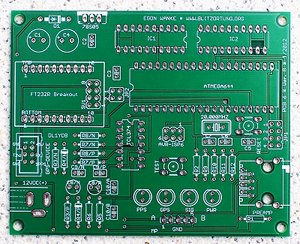 In a few weeks, we will replace the current amplifier and controller boards PCB 5 Ver. 7 and PCB 6 Ver. 8usb by new boards denoted by PCB 12 Vers. 2 and PCB 10 Vers. 2. The current amplifier board is already sold out, but we still have a small amount of the controller boards PCB 6 vers. 8usb. If you want to renew an older system, we sell these controller boards while stocks last for 5 Euro each. We can add a programmed ATmega644 for additional 5 Euro.
In a few weeks, we will replace the current amplifier and controller boards PCB 5 Ver. 7 and PCB 6 Ver. 8usb by new boards denoted by PCB 12 Vers. 2 and PCB 10 Vers. 2. The current amplifier board is already sold out, but we still have a small amount of the controller boards PCB 6 vers. 8usb. If you want to renew an older system, we sell these controller boards while stocks last for 5 Euro each. We can add a programmed ATmega644 for additional 5 Euro.
 Shipping to Germany: 3 Euro, to european countries: 4 Euro; please contact blitzortung@gmx.org
Shipping to Germany: 3 Euro, to european countries: 4 Euro; please contact blitzortung@gmx.org
22. February 2013
The German regional competition "Young Scientist" organized by "Stiftung Jugend forscht" was held this year on February 22 in Mainz. Three members of the lightning detection working group (from Otto-Hahn-Gymnasium Landau, Germany), Lena Bär, Dorian Werner and Henrik Wagner participated in the category "physics". They assembled and took into operation a lightning location system for the global lightning detection network Blitzortung.org. The team was able to prevail against eight others, some outstanding projects! The first place in their age-group allows them to participate at the federal competition in April. Additionally, they were awarded with the prize for the best interdisciplinary work. The jury was impressed by the presentation and the deep knowledge of the participants.
The lightning location team of the Otto-Hahn-Gymnasium also participated in our meeting last year in Schwangau. Have fun!
5. January 2013
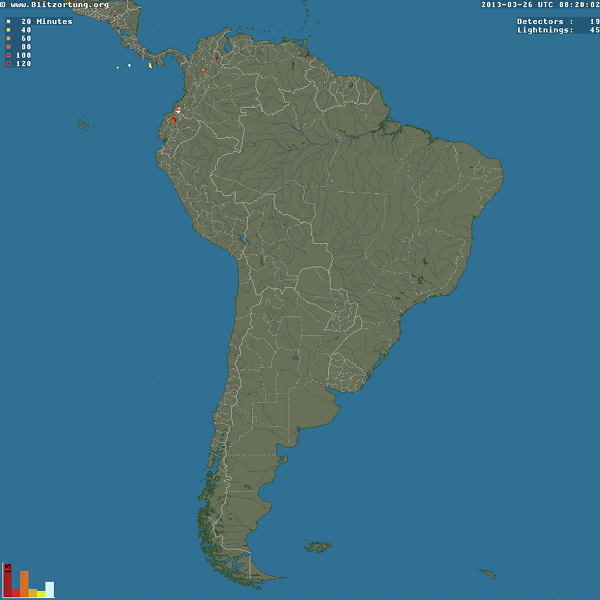
We have started our lightning location in South America. The first lightning discharges are computed from the data of the staton in Cúcuta together with the data of the stations from the US.
You are welcome to extend our network in South America.
15. September 2012
The second workshop of Blitzortung.org was held on Saturday 15. September 2012 in Schwangau, Germany. 26 participants talked about various topics, exchanged a lot of experiences, and discussed future developments for Blitzortung.org. The meeting began at 11 o'clock and took late into the evening. We thank Robert for the excellent organisation of the workshop. The picture shows the participants standing on the grass behind the house brewery Schlossbrauhaus Schwangau. The center of the picture shows Schloss Neuschwanstein in the background. The castle unfortunately has been surrounded by scaffolding, because of restoration work on the west and north facade.
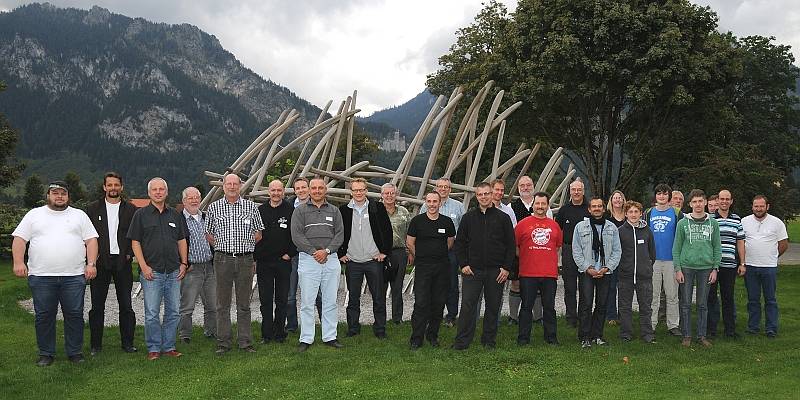 From lefft to right: (1) Robert, (2) Rolf, (3) Egon, (4) Fredi, (5) Heinrich, (6) Gregor, (7) Jochen, (8) Manfred, (9) Martin, (10) Heinz, (11) Uwe, (12) René, (13) Bernd, (14) Andreas, (15) Stefan, (16) Wolfgang, (17) Thomas R., (18) Thomas P., (19) Marion, (20) Tassilo, (21) Dorian, (22) Edmund, (23) Lars, (24) Peter M., (25) Tobias, (26) Peter K.
1. June 2012
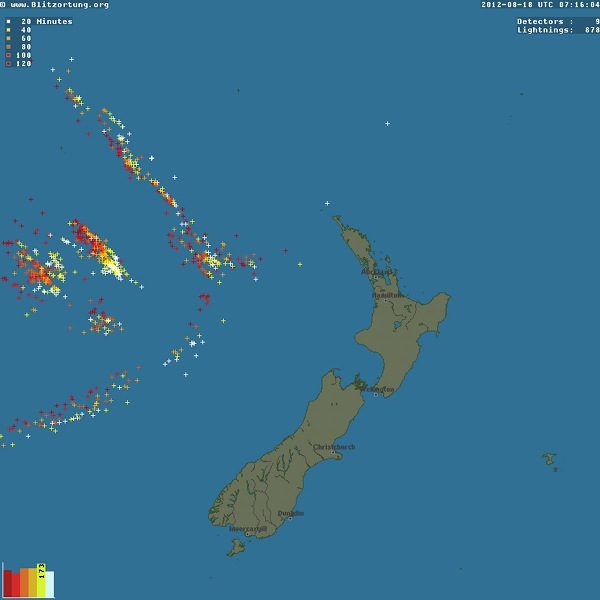
We have started our lightning location in New Zealand. The first lightning discharges are computed from the data of three detectors located at Hamilton, Aukland, and Kerikeri.
You are welcome to extend our network in Oceania.
22. May 2012
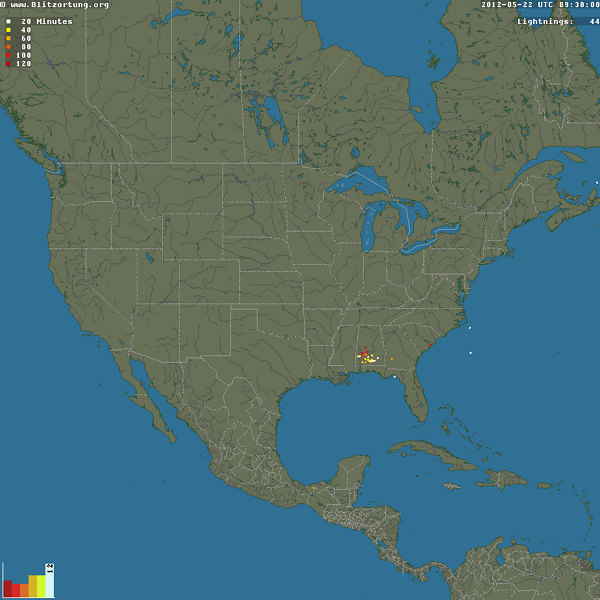
We have started our lightning location in North America. The first lightning discharges are computed from the data of three detectors located at San Antonio/Texas, Salt Lake City/Utha, and Palm Beach Gardens/Florida.
You are welcome to extend our network in North America.
21. April 2012

We have opened three new forums where the participants of Blitzortung.org and those who want to become a participant of Blitzortung.org, can discuss everything about how to setup an own TOA lightning detector.
- French forum: www.blitzortung.fr
- US Forum: www.USAtoa.com
- Danish Forum: www.richos.dk
You can find further links to forums and faq-servers below on the "Cover your Area" page.
24. February 2012
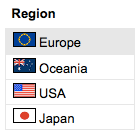
We have extended our system to handle several regions.
The change of the system to handle several regions has now been finished. Currently, there are two servers in operation for receiving data, one for Region 1 (Europe) and one for Region 2 (Oceania). Other regions can easily be added. Especially people from unsupported areas are encouraged to participate in our lightning detection network. We will extend the system to any region from which we will get lightning data.
Every user has access to the lightning data from all regions, but needs a separate username for each region to send data.
31. Januar 2012
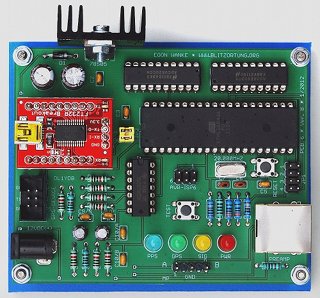
The new USB board PCB 6 Version 8usb replaces the old PCB 6 Version 7 board.
The new board uses cheaper A/D converters and an ATMega644A microcontroller with two UARTs. This allows to use different transmission speeds. The transmission speed between the board and the GPS module can be iadjusted to 4800 Baud, 9600 Baud, 19200 Baud, or 38400 Baud. The transmission speed between the board and the PC can be adjusted to 115200 Baud, 230400 Baud, 250000 Baud, or 500000 Baud. We hope that this will finally eliminate all transmission errors of previous boards.
The board outputs for every signal 256 bytes of each channel sampled with 512 kHz. It needs Windows tracker Version 6.xx.x or Linux tracker Version 25.
16. Januar 2012

We have introduced new maps.
The old maps of size 650x650 pixels are replaced by new maps of size 950x950 pixel.
10. Januar 2012

We sell of while supply last:
PCB 6.6 (the board with the RS232 interface) for 5 Euro each and the necessary analog-to-digital converters AD7813 for 5 Euro each.
Shipping to Germany: 3 Euro, to european countries: 4 Euro; please contact blitzortung@gmx.org.
(10. February 2012: The analog-to-digital converters AD7813 are sold out. We will not order more of these ADCs.)
(23. July 2012: PCB 6 Version 6 are sold out, but PCB 6 Version 8 can also be used with an RS232 breakout borad.)
|
|

 Board 22.2 has been slightly improved and is now available in version 22.2c. The changes concern the wiring of the external connections for the LEDs and the three buttons. These signals have been routed to a pin header. With an additional breadboard, seven LEDs and three buttons can be easily routed to the front and rear of the housing. The breadboard contains no SMD components. Only the LEDs, buttons, and a female header must be manually soldered onto the board. The front and rear panels have been slightly modified to accommodate the new components. In addition, the 4.5-volt voltage converter LP5907MFX-4.5NPB for the preamplifier power supply has been replaced with the current limiter MIC2009A-2YM6-TR. This limits the preamplifier current to a maximum of 200 mA and protects against damage if the H-field preamplifier connection cable is swapped with the LAN cable on the detector.
Board 22.2 has been slightly improved and is now available in version 22.2c. The changes concern the wiring of the external connections for the LEDs and the three buttons. These signals have been routed to a pin header. With an additional breadboard, seven LEDs and three buttons can be easily routed to the front and rear of the housing. The breadboard contains no SMD components. Only the LEDs, buttons, and a female header must be manually soldered onto the board. The front and rear panels have been slightly modified to accommodate the new components. In addition, the 4.5-volt voltage converter LP5907MFX-4.5NPB for the preamplifier power supply has been replaced with the current limiter MIC2009A-2YM6-TR. This limits the preamplifier current to a maximum of 200 mA and protects against damage if the H-field preamplifier connection cable is swapped with the LAN cable on the detector.
 The System Blue Basic, or Blue Basic for short, is a System Blue in which some unimportant components have been omitted for cost reasons. It still supports two H-field channels, the primary application of the detectors. The third H-field channel and the E-field channel have been omitted. Furthermore, certain filter options that should only be used in noisy environments have been omitted. The detector works optimally with the 23.1 preamplifier board. The new GNSS module is the u-blox MAX-M10S. It supports the simultaneous reception of various GNSS signals (GPS, GLONASS, Galileo, and BeiDou). Blue Basic is now powered via a USB-C port. Possible front panels for installation in a 100 x 100 mm metal housing are in preparation.
The System Blue Basic, or Blue Basic for short, is a System Blue in which some unimportant components have been omitted for cost reasons. It still supports two H-field channels, the primary application of the detectors. The third H-field channel and the E-field channel have been omitted. Furthermore, certain filter options that should only be used in noisy environments have been omitted. The detector works optimally with the 23.1 preamplifier board. The new GNSS module is the u-blox MAX-M10S. It supports the simultaneous reception of various GNSS signals (GPS, GLONASS, Galileo, and BeiDou). Blue Basic is now powered via a USB-C port. Possible front panels for installation in a 100 x 100 mm metal housing are in preparation.
 The H-field preamplifiers for the System Blue detector are now also available as individual boards. Originally, the H-field preamplifiers were only delivered together with the detector on one panel. With several preamplifiers, several different antenna systems, such as ferrite antennas and loop antennas, can now easily be exchanged. This makes it easier to test different antennas. In addition, individual preamplifiers often fail due to weather conditions. The boards can up to now be delivered in any quantity. Simply contact us by email.
The H-field preamplifiers for the System Blue detector are now also available as individual boards. Originally, the H-field preamplifiers were only delivered together with the detector on one panel. With several preamplifiers, several different antenna systems, such as ferrite antennas and loop antennas, can now easily be exchanged. This makes it easier to test different antennas. In addition, individual preamplifiers often fail due to weather conditions. The boards can up to now be delivered in any quantity. Simply contact us by email.
 Since the end of 2023, we have been using the Sentinel-2 cloudless Copernicus satellite images from 2022 in the
Since the end of 2023, we have been using the Sentinel-2 cloudless Copernicus satellite images from 2022 in the 


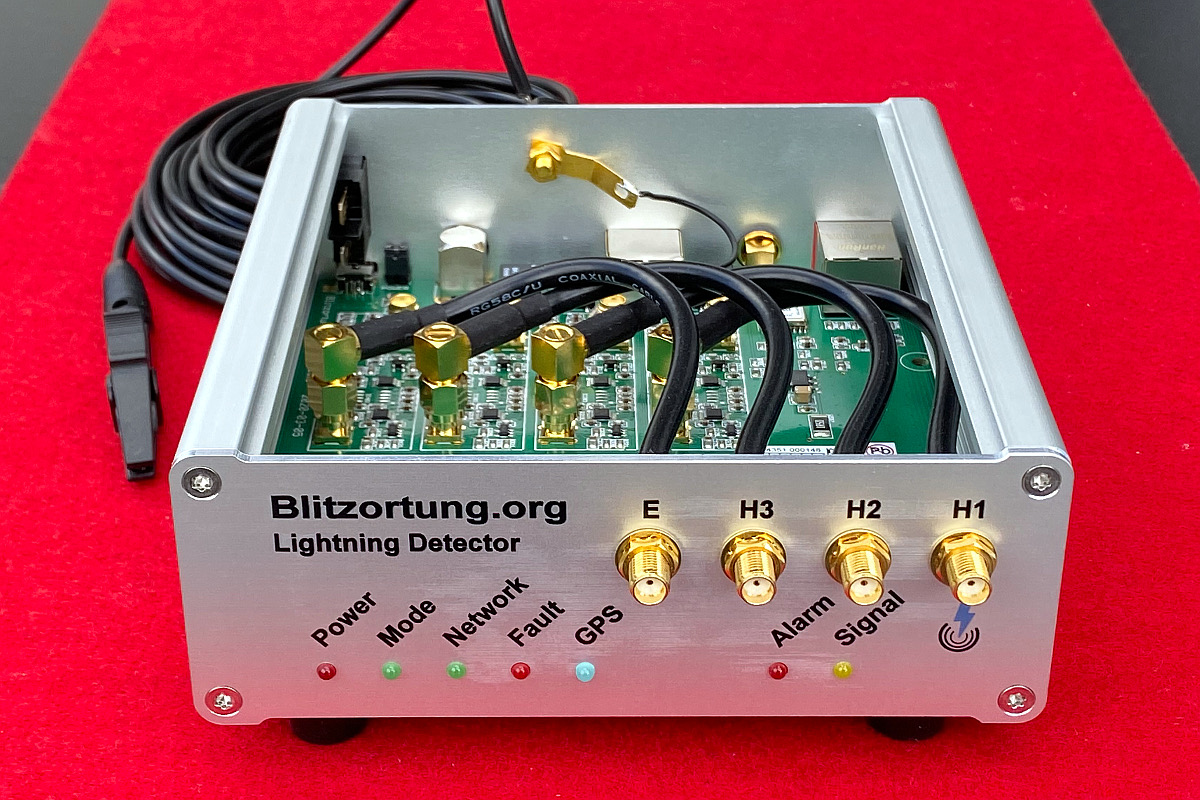 Since our supplier for ferrite rod antennas has been retired, electrical antennas have become more and more popular. However, installing an electrical antenna is much more complicated than installing a magnetic loop antenna. Electrical antennas are often set up incorrectly. A short active monopole antenna can be considered as a capacitor surface. The electric field causes a potential difference between the antenna surface and the ground. These antennas can only function outside and away from buildings. The shape of the antenna, whether rod or area, is of secondary importance. The field strength of the received signal increases with the antenna height, as long as it is small in relation to the wavelength. Increasing the antenna area also increases the receiving voltage, but there is a risk that the receiver will be overdriven. In practice, it has been shown that increasing the size of the antenna no longer improves the signal-to-noise ratio, since then external noises dominates.
Since our supplier for ferrite rod antennas has been retired, electrical antennas have become more and more popular. However, installing an electrical antenna is much more complicated than installing a magnetic loop antenna. Electrical antennas are often set up incorrectly. A short active monopole antenna can be considered as a capacitor surface. The electric field causes a potential difference between the antenna surface and the ground. These antennas can only function outside and away from buildings. The shape of the antenna, whether rod or area, is of secondary importance. The field strength of the received signal increases with the antenna height, as long as it is small in relation to the wavelength. Increasing the antenna area also increases the receiving voltage, but there is a risk that the receiver will be overdriven. In practice, it has been shown that increasing the size of the antenna no longer improves the signal-to-noise ratio, since then external noises dominates.
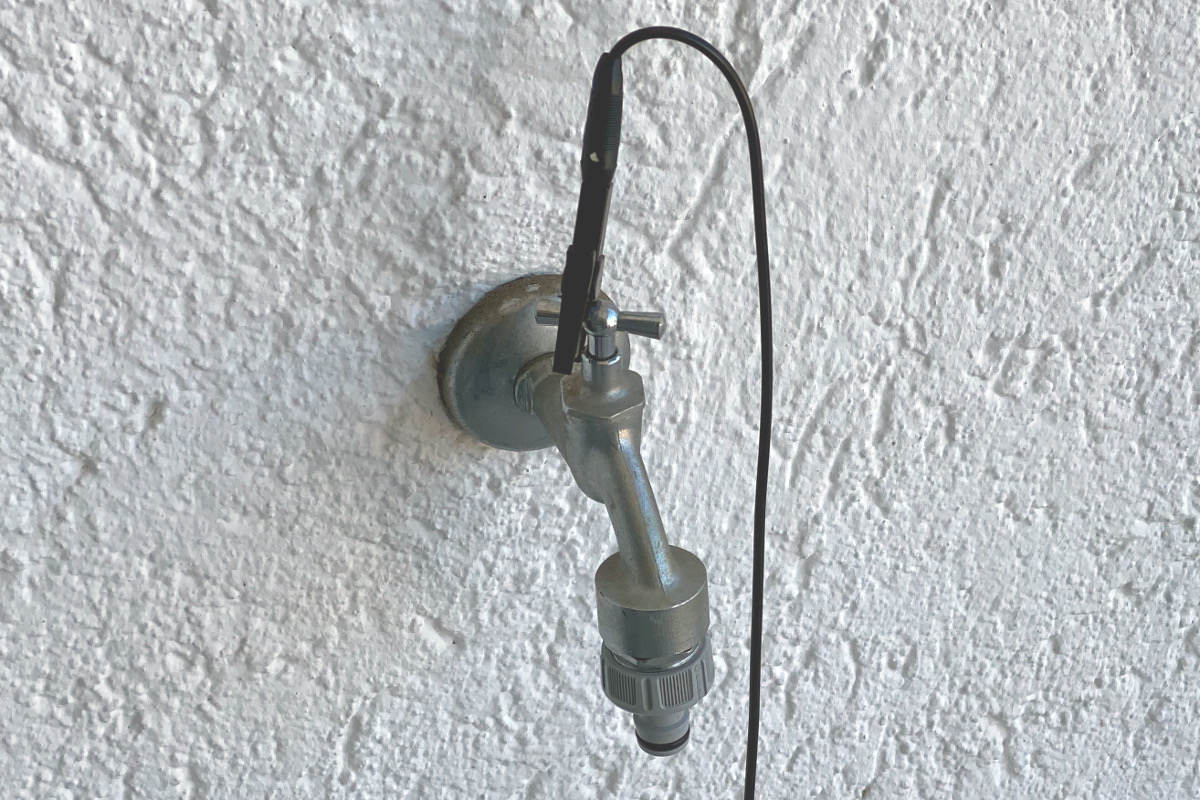
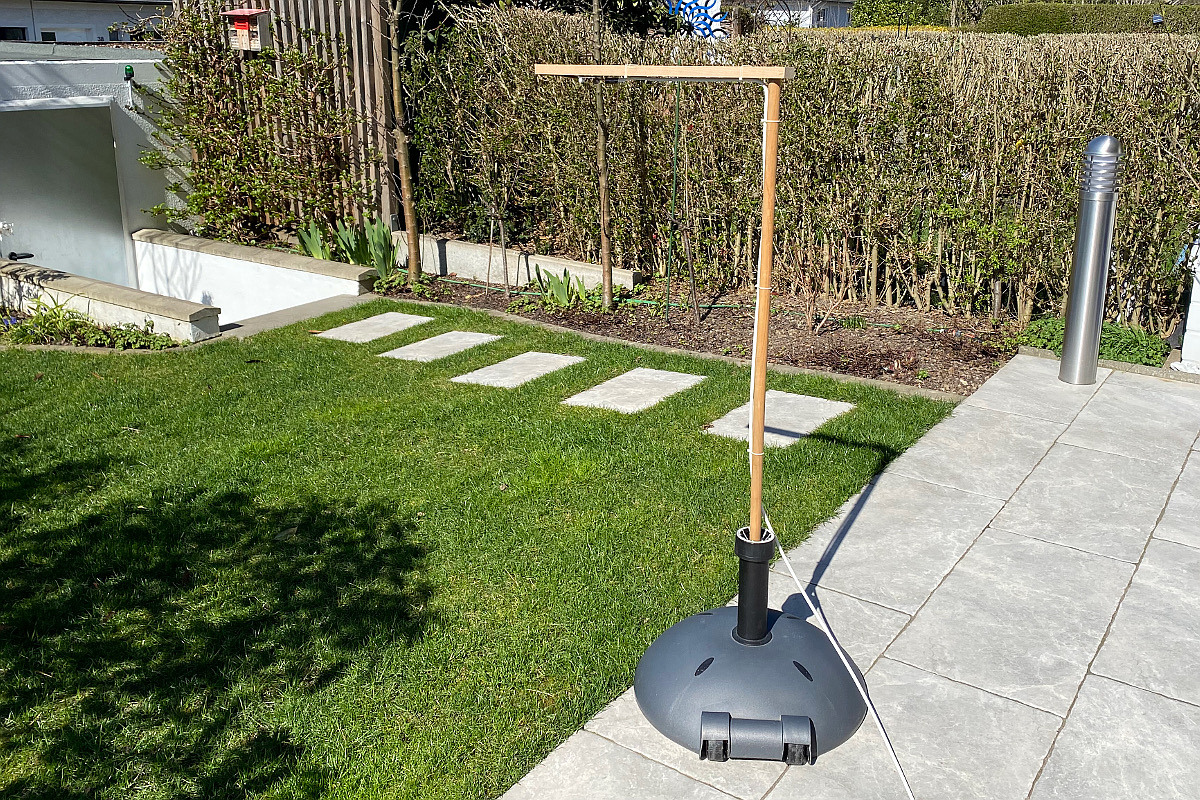
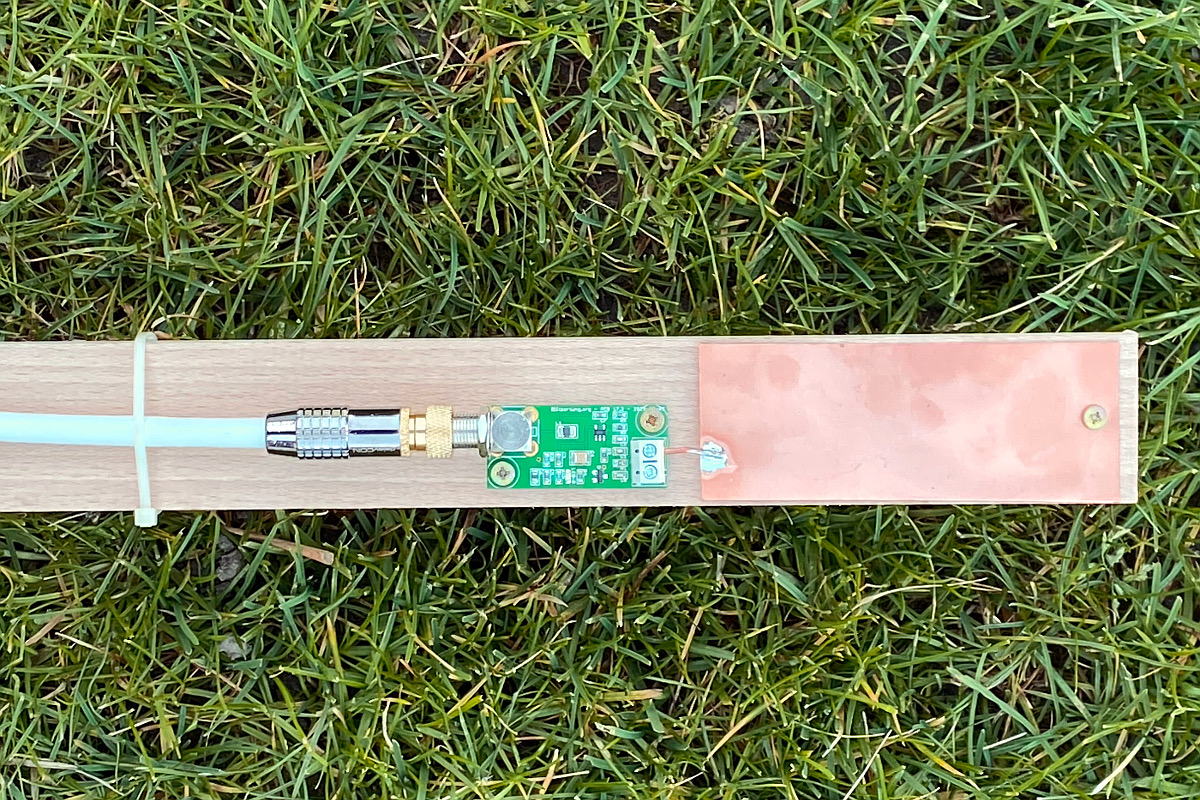
 The Swiss Federal Office for Environment (BAFU Bundesamt für Umwelt) has set up the task of providing data and information that can serve as a basis for environmental discussions and decisions. For this purpose, the BAFU operates observation programs and measuring networks. Today a meeting of the BAFU took place at Lake Thun, where various digital projects were presented. One of these projects for environmental observations was the lightning location network Blitzortung.org. More Images can be found at
The Swiss Federal Office for Environment (BAFU Bundesamt für Umwelt) has set up the task of providing data and information that can serve as a basis for environmental discussions and decisions. For this purpose, the BAFU operates observation programs and measuring networks. Today a meeting of the BAFU took place at Lake Thun, where various digital projects were presented. One of these projects for environmental observations was the lightning location network Blitzortung.org. More Images can be found at  After the discontinuation of the Google Maps for cost reasons, the main focus in the last 6 months has been on the development of a new dynamic map. The use of vector tiles unfortunately requires a bit more resources on the browser side, but in contrast to the old maps one has more possibilities to realize things very easily. Vector graphics make the system highly flexible. The new maps are now based on data from OpenStreetMap and are therefore probably permanently available free of charge. Thanks to all contributors of OpenStreetMap.
After the discontinuation of the Google Maps for cost reasons, the main focus in the last 6 months has been on the development of a new dynamic map. The use of vector tiles unfortunately requires a bit more resources on the browser side, but in contrast to the old maps one has more possibilities to realize things very easily. Vector graphics make the system highly flexible. The new maps are now based on data from OpenStreetMap and are therefore probably permanently available free of charge. Thanks to all contributors of OpenStreetMap.
 The number of stations in Japan and the surrounding area has increased considerably. This has made the East Asian area around Japan its own region within the lightning detection network. This spring, more stations will be put into operation. Together with the stations in Vietnam, Cambodia, Thailand and Malaisia, it is possible for the first time to detect lightning over East Asia.
The number of stations in Japan and the surrounding area has increased considerably. This has made the East Asian area around Japan its own region within the lightning detection network. This spring, more stations will be put into operation. Together with the stations in Vietnam, Cambodia, Thailand and Malaisia, it is possible for the first time to detect lightning over East Asia.

 Detector number 2204 was built on the Mountain Hochfelln in Bavaria/Germany at an altitude of 1700 meters. The station already set a reception record of over 11700km after one day. Here are some pictures of the construction.
Detector number 2204 was built on the Mountain Hochfelln in Bavaria/Germany at an altitude of 1700 meters. The station already set a reception record of over 11700km after one day. Here are some pictures of the construction.
 The old GNSS module was unfortunately no longer available. Therefore, a new GNSS module was integrated on the new Board 19.5, the UBLOX MAX M8W. The MAX-M8 modules utilize concurrent reception of up to three GNSS systems (GPS/Galileo together with either Bei-Dou or GLONASS) for more reliable positioning.
The old GNSS module was unfortunately no longer available. Therefore, a new GNSS module was integrated on the new Board 19.5, the UBLOX MAX M8W. The MAX-M8 modules utilize concurrent reception of up to three GNSS systems (GPS/Galileo together with either Bei-Dou or GLONASS) for more reliable positioning.

 The repair or maintenance of a detectors can be very cumbersome in remote areas. The GPS had failed for some unknown reason at detector number 2010 in Krong Suong, Cambodia. To reach this detector, a distance of over 100km had to be covered. Such a journey through Cambodia usually takes 6 hours. Dust is a particular problem in this region. A Detector only works for a few months. After a few months, a detector looks like the one at the picture below.
The repair or maintenance of a detectors can be very cumbersome in remote areas. The GPS had failed for some unknown reason at detector number 2010 in Krong Suong, Cambodia. To reach this detector, a distance of over 100km had to be covered. Such a journey through Cambodia usually takes 6 hours. Dust is a particular problem in this region. A Detector only works for a few months. After a few months, a detector looks like the one at the picture below.
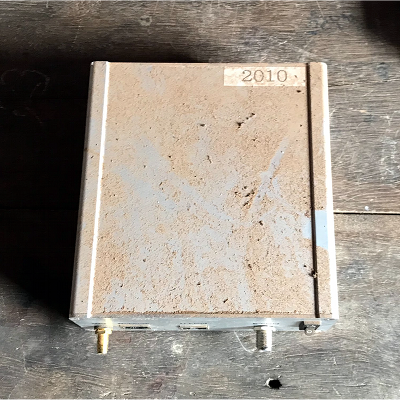

 The new detectors with the mainboard 19.4 are finally available after a long waiting period. The improvements included among other things the noise immunity of channel A and the zero lines of four channels. An additional grounding socket was attached to the backpanel of the housing. This now well-working version of the detector will be offered in 2018 in larger quantities.
The new detectors with the mainboard 19.4 are finally available after a long waiting period. The improvements included among other things the noise immunity of channel A and the zero lines of four channels. An additional grounding socket was attached to the backpanel of the housing. This now well-working version of the detector will be offered in 2018 in larger quantities.

 Meanwhile, there is a considerable number of stations in Japan such that our lightning location already works quite well there. More stations in Japan are being built. A large number of these stations are operated by Professor Tomomi Narita who visited us in Düsseldorf in April 2017. So another country has joined our projekt. Have fun with Blitzortung.org in Japan.
Meanwhile, there is a considerable number of stations in Japan such that our lightning location already works quite well there. More stations in Japan are being built. A large number of these stations are operated by Professor Tomomi Narita who visited us in Düsseldorf in April 2017. So another country has joined our projekt. Have fun with Blitzortung.org in Japan.
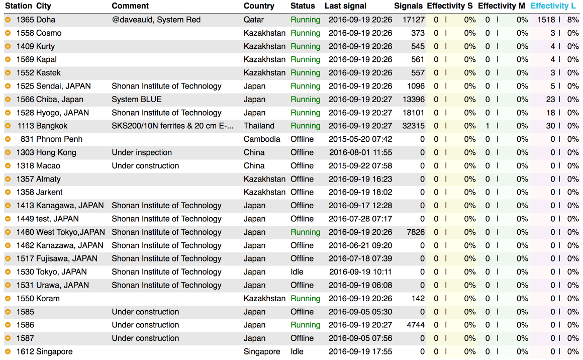
 We have started with the delivery of the new System Blue kits. The first 50 stations were ordered within the first 24 hours. Since the demand is currently very high, additional detectors are already reordered. Unfortunately it always takes some weeks until the boards are manufactured and soldered.
We have started with the delivery of the new System Blue kits. The first 50 stations were ordered within the first 24 hours. Since the demand is currently very high, additional detectors are already reordered. Unfortunately it always takes some weeks until the boards are manufactured and soldered.


 Blitzortung.org was presented at the meeting "Advances in Lightning Detection Methods" at University of Reading in the UK. This meeting seeks to review the current technology available for lightning detection, including ground based radio detection and electrostatic methods, as well as satellite detection methods. Current limitations of the technology as well as future developments will be discussed by experts from both the lighting detection industry as well as academia.
Blitzortung.org was presented at the meeting "Advances in Lightning Detection Methods" at University of Reading in the UK. This meeting seeks to review the current technology available for lightning detection, including ground based radio detection and electrostatic methods, as well as satellite detection methods. Current limitations of the technology as well as future developments will be discussed by experts from both the lighting detection industry as well as academia.

 Blitzortung.org has its first participant from Japan.
Blitzortung.org has its first participant from Japan.
 The web pages of Blitzortung.org have been adapted to improve the readability of most of our pages on mobile devices. This modification also affects the language dependent menus. If your native language is not supported then please contact us at info ☺ blitzortung.org. We send you further information how to install a missing language.
The web pages of Blitzortung.org have been adapted to improve the readability of most of our pages on mobile devices. This modification also affects the language dependent menus. If your native language is not supported then please contact us at info ☺ blitzortung.org. We send you further information how to install a missing language.

 Blitzortung.org has its first participant from South Africa.
Blitzortung.org has its first participant from South Africa.
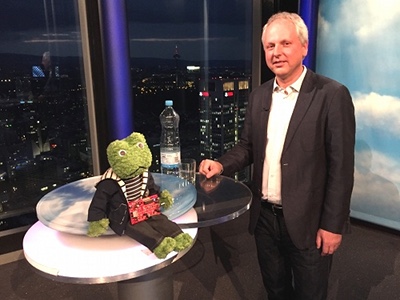
 Announcement of System BLUE
Announcement of System BLUE
 Blitzortung was presented at the 2014 New Zealand Meteorological Conference, to which we had an excellent outcome for the Blitzortung Community. The Conference ran for 3 days from the 19th to 21st of November and explored various parts of the Worlds Atmosphere, Climate and specific Meteorological Events that New Zealand and the World has had. Lightning Research and characteristics in New Zealand where also discussed. A big thank you goes towards the organisers of the conference.
Blitzortung was presented at the 2014 New Zealand Meteorological Conference, to which we had an excellent outcome for the Blitzortung Community. The Conference ran for 3 days from the 19th to 21st of November and explored various parts of the Worlds Atmosphere, Climate and specific Meteorological Events that New Zealand and the World has had. Lightning Research and characteristics in New Zealand where also discussed. A big thank you goes towards the organisers of the conference.

 Blitzortung.org has its first participant from Bangkok.
Blitzortung.org has its first participant from Bangkok.


 Blitzortung.org has its first participant from Mexico.
Blitzortung.org has its first participant from Mexico.

 Blitzortung.org has found its first participant amid of the Pacific Ocean. The new station in Hawaii has been in operation since a few days. Due to the specific position, the station sends its data to our server for North America and our server for Oceania.
Blitzortung.org has found its first participant amid of the Pacific Ocean. The new station in Hawaii has been in operation since a few days. Due to the specific position, the station sends its data to our server for North America and our server for Oceania.
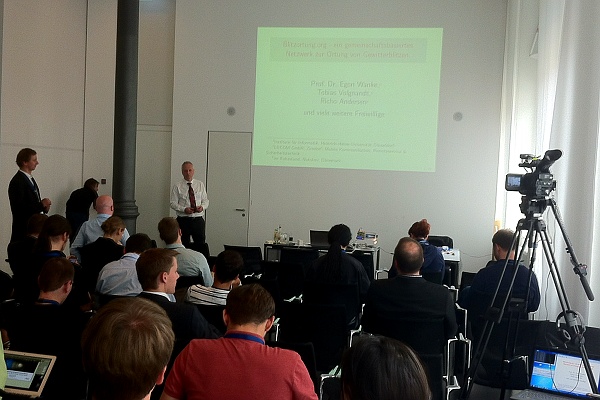
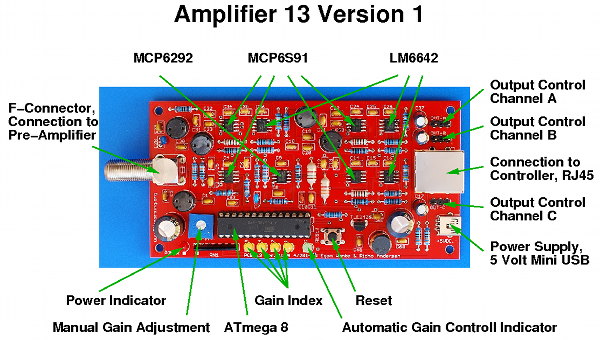
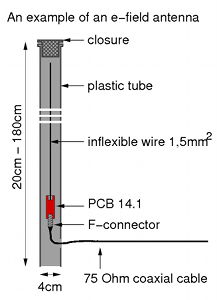
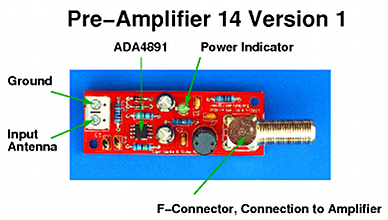

 In a few weeks, we introduce a solution for the use of an electric antenna. Any wire or copper surface can be used as electric antenna. The antenna is connected to the small preamplifier PCB 14. The signal from the preamplifier can be passed through coaxial cable up to 100 meter to the amplifier PCB 13. Amplifier PCB 13 uses an adapted high-pass filter and in contrast to amplifier PCB 12 three different low-pass filters routed to the three input channels of the controller. The electric antenna should be at least 5 meters outside of living areas or houses, otherwise the interference of electrical household appliances can be too large. We will inform you here when the boards PCB 13 and PCB 14 are available.
In a few weeks, we introduce a solution for the use of an electric antenna. Any wire or copper surface can be used as electric antenna. The antenna is connected to the small preamplifier PCB 14. The signal from the preamplifier can be passed through coaxial cable up to 100 meter to the amplifier PCB 13. Amplifier PCB 13 uses an adapted high-pass filter and in contrast to amplifier PCB 12 three different low-pass filters routed to the three input channels of the controller. The electric antenna should be at least 5 meters outside of living areas or houses, otherwise the interference of electrical household appliances can be too large. We will inform you here when the boards PCB 13 and PCB 14 are available.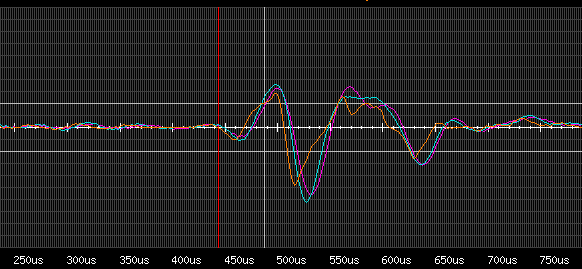

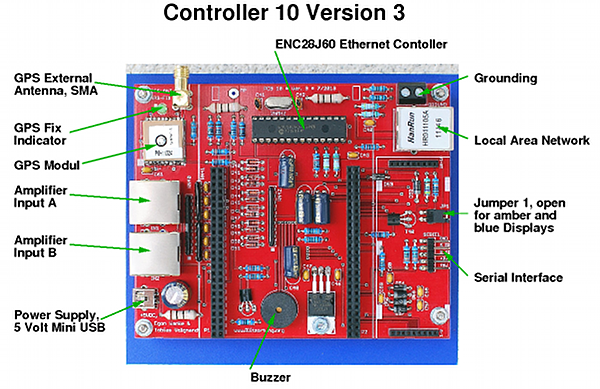
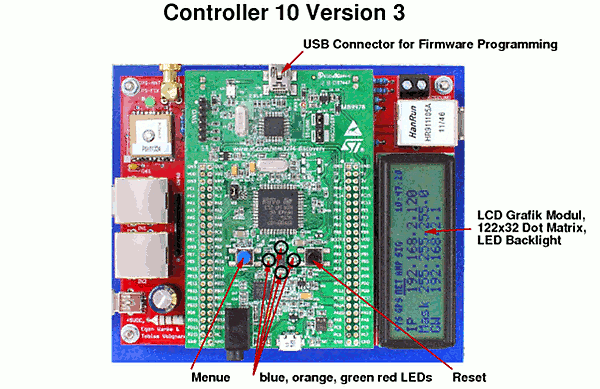
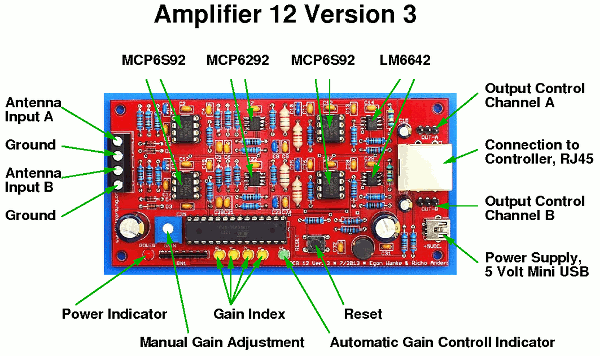
 In a few weeks, we will replace the current amplifier and controller boards PCB 5 Ver. 7 and PCB 6 Ver. 8usb by new boards denoted by PCB 12 Vers. 2 and PCB 10 Vers. 2. The current amplifier board is already sold out, but we still have a small amount of the controller boards PCB 6 vers. 8usb. If you want to renew an older system, we sell these controller boards while stocks last for 5 Euro each. We can add a programmed ATmega644 for additional 5 Euro.
In a few weeks, we will replace the current amplifier and controller boards PCB 5 Ver. 7 and PCB 6 Ver. 8usb by new boards denoted by PCB 12 Vers. 2 and PCB 10 Vers. 2. The current amplifier board is already sold out, but we still have a small amount of the controller boards PCB 6 vers. 8usb. If you want to renew an older system, we sell these controller boards while stocks last for 5 Euro each. We can add a programmed ATmega644 for additional 5 Euro.
 Shipping to Germany: 3 Euro, to european countries: 4 Euro; please contact blitzortung@gmx.org
Shipping to Germany: 3 Euro, to european countries: 4 Euro; please contact blitzortung@gmx.org
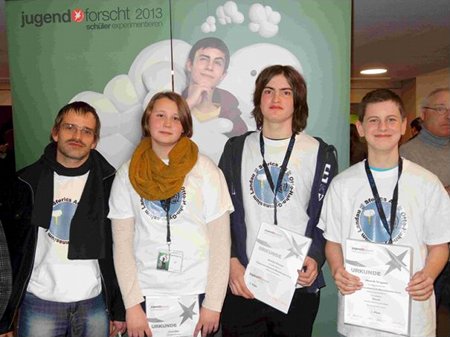
 We have started our lightning location in South America. The first lightning discharges are computed from the data of the staton in Cúcuta together with the data of the stations from the US.
We have started our lightning location in South America. The first lightning discharges are computed from the data of the staton in Cúcuta together with the data of the stations from the US.

 We have started our lightning location in New Zealand. The first lightning discharges are computed from the data of three detectors located at Hamilton, Aukland, and Kerikeri.
We have started our lightning location in New Zealand. The first lightning discharges are computed from the data of three detectors located at Hamilton, Aukland, and Kerikeri.
 We have started our lightning location in North America. The first lightning discharges are computed from the data of three detectors located at San Antonio/Texas, Salt Lake City/Utha, and Palm Beach Gardens/Florida.
We have started our lightning location in North America. The first lightning discharges are computed from the data of three detectors located at San Antonio/Texas, Salt Lake City/Utha, and Palm Beach Gardens/Florida.
 We have opened three new forums where the participants of Blitzortung.org and those who want to become a participant of Blitzortung.org, can discuss everything about how to setup an own TOA lightning detector.
We have opened three new forums where the participants of Blitzortung.org and those who want to become a participant of Blitzortung.org, can discuss everything about how to setup an own TOA lightning detector.
 We have extended our system to handle several regions.
We have extended our system to handle several regions.
 The new USB board PCB 6 Version 8usb replaces the old PCB 6 Version 7 board.
The new USB board PCB 6 Version 8usb replaces the old PCB 6 Version 7 board.
 We have introduced new maps.
We have introduced new maps.
 We sell of while supply last:
We sell of while supply last:
